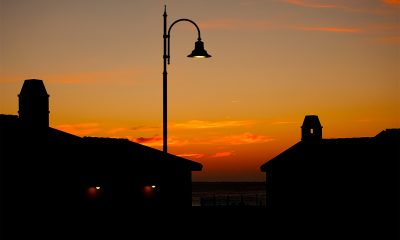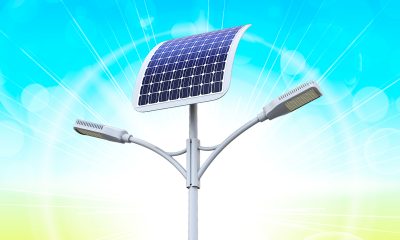What is a catenary street light
A catenary street light is a street lighting luminaire that is strung on a structural cable. The structural cable is an overhead wire that is suspended between two support structures (buildings, poles, etc.). The term ‘catenary’ refers to the curve formed when a cable hangs under its own weight. In the architectural engineering sector a catenary relates to a system of overhead wires. In Continental Europe, the overhead catenary system is often used to mount area and street lighting systems which are normally installed on poles.
The use of catenary lighting systems eliminates visual clutter associated with lines of street light poles and saves spaces for narrow or high pedestrian activity streets. It also provides the luminaire mounting flexibility required to optimize light distributions for a best possible visual environment and maximized fixture spacing. Catenary street lights are mostly used on downtown streets, shopping districts, car-free zones, internal road networks within a city block, narrow public ways of a residential area, and roads with no medians and sidewalks.
Lighting technology
For decades, high-intensity discharge (HID) lamps which produce light by means of an electrical arc discharge had been the foremost sources of catenary street lighting systems. There has been over the past decade a monumental technology move toward replacing HID fixtures which use metal halide (MH) or high pressure sodium (HPS) lamps with LED lighting systems. The justifications for switching to LED lighting are the longer life span, enormous efficiency of energy consumption, reduced maintenance costs of LED lights and the opportunity for strong differentiation via lighting design and additional functionalities.
A prominent advantage of implementing LED lighting in catenary lighting installations is the small EPA (Effective Projected Area) of LED lights. Catenary mounting systems require tight control of the luminaire EPA due to the limited strength of catenary cables. Unlike HID lamps that require large metal reflectors to control the distribution of light from the omni-directional light bulbs, LED lighting eliminates the need for large optical systems thanks to small size of the semiconductor light source. The directional output and optical controllability with package-level lenses allow an LED street light to deploy a low profile, aerodynamic design that projects a very small surface area to the wind.
Light distribution characteristics
Catenary street lights are typically strung at or near center of a road or area and provide area or street lighting in the IES type I (short, medium, or long), type V, or type VS distribution. A catenary LED street light is most often a direct lighting system that direct almost all of the light downward. An array of discrete LEDs can be populated on a circuit board to form a light emitting surface (LES) that is optimized to the light distribution requirement of any application and deliver high uniformity lighting within the defined area. In contrast, an HID lamp is high-intensity nearpoint source that concentrates its luminous flux around the rotation axis of the symmetric optical system, which results in a much higher illuminance density on the area directly below the luminaire than areas farther away from the luminaire.
Catenary street lighting is typically provided to roads that carry a large portion of pedestrian traffic. Aside from uniform distribution of ample horizontal illuminance, a proper amount of vertical illuminance (e.g., 5 to 10 lux for high pedestrian conflict areas) should be provided to ensure adequate visibility of pedestrians and cyclists. The horizontal and vertical illuminances produced by an LED luminaire can be precisely controlled with close-coupled compound lenses that extract light directly from the source and distribute it through key vertical and horizontal planes.
Light source
LED luminaires are complex, sophisticated systems capable of reaching high performances over the rated system life only when each of their main components, which include the LEDs and the thermal, electrical, optical and mechanical systems, is properly chosen and specifically designed to address the related system operating requirements. The luminaire is the final custom element that tailors how the light produced from the LEDs and its operating behavior fit into an application. Catenary LED street lights are offered in lumen packages ranging from 1,200 to 15,000. The luminaire efficacy is the cumulative efficiency of its LEDs, driver and optics.
The most used types of LED packages in catenary lighting systems are mid-power LEDs and high power LEDs. Mid-power LEDs are frequently incorporated into low output or low cost systems due to their low prices and high luminous efficacy. However, these LED packages are prone to accelerated lumen depreciation due to the poor thermal and photo stability of the plastic housing at high temperatures and long operating times. High power LEDs, despite the relatively low source efficacy due to the absence of the reflective plastic housing and leadframe, are capable of delivering consistent performance over a long lifespan. Their package platform allows the LEDs to be driven at high current density and survive a high operating temperature.
Thermal management
The LEDs are mounted onto a metal core printed circuit board (MCPCB) with the solder joint or interconnect reliability meeting strict requirements for outdoor lighting applications. The LED board is accommodated by a heat sink which serves to conduct the heat released by the LEDs away from the MCPCB and then to convect and radiate heat to the ambient air. A thermal interface material (TIM), which can be a grease, epoxy or pad, is placed between the heat sink and circuit board to fill the air gaps between adjacent surfaces and thus remove interfacial thermal resistance.
The heat sink plays a big part in maximizing the efficiency of the thermal path. It is typically constructed from die cast, extruded or cold forged low copper aluminum alloy, with the effective thickness and surface area scaled to the thermal load dissipation requirement.
Even with adequate heat sinking, effective thermal management requires control of the drive current because temperature increases in LEDs can be caused not only by high ambient temperatures, but also excessively high drive currents. When a higher drive current is applied to the LEDs, there is increased heat generation. Overdriving what the LED is rated for can accelerate the nucleation and growth of thread dislocations and other atomic defects in the active region of the LED chip.
LED driving and dimming
At the core of the catenary LED street light is the line-operated LED driver which provides AC-DC power conversion and load regulation. Typically, the LED driver uses a switching power supply to regulate the amount of electrical power applied to the LED array. The conversion from the incoming AC line power to the regulated DC output current is accomplished through a one-stage or two-stage topology. A one-step conversion maximizes circuit efficiency and reduces cost but is limited to low-power designs with narrow operating voltages because of the high current and voltage stresses imposed on power MOSFETs. At higher power levels, the two-stage design performs more efficiently and reliably with respect to the single stage solution, despite the substantial increase in its cost and size. Other advantageous features of a two-stage LED driver are a wide input voltage range and full range dimming capability.
The LED driver also needs to execute many sub-tasks sequentially or in parallel. One of these sub-tasks is to safeguard reliable driver operation and protect the connected LED modules against line voltage fluctuations. A high surge immunity on system level is critical to the reliable operation of an outdoor luminaire. Many drivers allow dimming of the connected LEDs in the amplitude modulation (AM) or pulse-width modulation (PWM) mode and accept control input through a DALI, 0-10V DC, or wireless control interface. These devices may also respond to the changes in environmental attributes via the connected occupancy sensors and photocells, thereby tailoring the delivery of light and implementing daylight harvesting according to pre-defined software rules.
Surviving the outdoor rigors
Catenary street lights are exposed to a range of environmental factors that can compromise performance and longevity of lighting fixtures. The heat sink design must take into account self-cleaning ability so as to prevent debris accumulation which can promote corrosive attack and reduce the heat sink performance. It’s often desirable to seal the luminaire to an IP66 rating for a high resistance to ingress of dust and moisture. Installing a respiratory system in a sealed enclosure enables pressure equalization, which contributes to protection against premature seal failure. To protect the aluminum housing against corrosion and other forms of deterioration, chemical surface treatments must be applied prior to the powder coating application.



















Loading...
New member